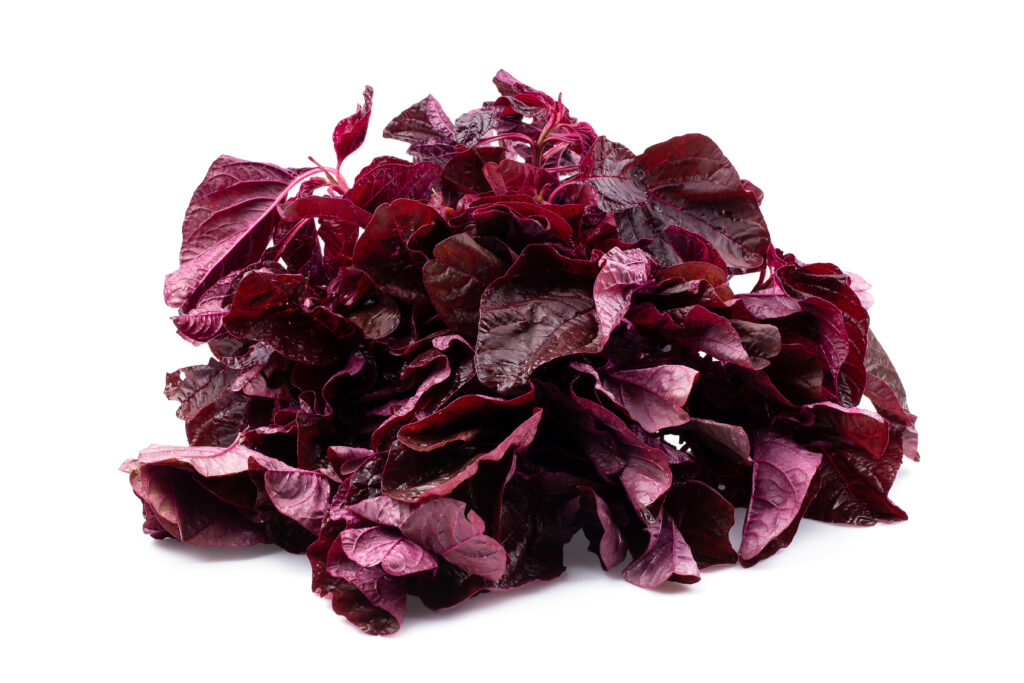Red spinach, also known as Amaranthus dubius, is a vibrant leafy vegetable packed with essential nutrients and powerful antioxidants. Unlike its green counterpart, red spinach stands out due to its striking reddish-purple leaves, which indicate a high anthocyanin content. This superfood has been cherished in traditional medicine for its numerous health benefits, ranging from boosting immunity to enhancing heart health.
A staple in many Asian and Indian cuisines, red spinach is not only delicious but also incredibly versatile. It is rich in vitamins, minerals, and phytonutrients that contribute to overall well-being.
If you’re aiming for a diet that nourishes your body with natural, wholesome foods, incorporating red spinach can be a game-changer. Let’s explore the various health benefits of this nutrient-dense leafy green.
Nutrient Profile
Red spinach is packed with essential nutrients. It is a great source of vitamins A, C, and K, which are crucial for maintaining healthy skin, boosting the immune system, and promoting bone health. Additionally, red spinach is rich in iron, calcium, magnesium, and potassium, which are vital for various bodily functions.
- Vitamin A: Supports eye health and boosts the immune system.
- Vitamin C: An antioxidant that protects against free radical damage and supports the immune system.
- Vitamin K: Essential for blood clotting and bone health.
- Iron: Crucial for red blood cell production and preventing anemia.
- Calcium: Important for bone health and muscle function.
- Magnesium and Potassium: Regulate blood pressure and support heart health.
Health Benefits
Here are the benefits of red spinach for health.
1. Rich in Antioxidants
Red spinach is loaded with antioxidants, particularly anthocyanins, which give the leaves their red color.
These antioxidants play a crucial role in neutralizing harmful free radicals in the body, reducing oxidative stress, and lowering the risk of chronic diseases such as cancer and heart disease.
The high antioxidant content also helps in slowing down the aging process, keeping your skin youthful and radiant.
2. May Support Heart Health
The nutrients found in red spinach, including potassium, magnesium, and dietary fiber, contribute to heart health.
Potassium helps regulate blood pressure by balancing the effects of sodium, while magnesium supports proper heart function.
Additionally, the dietary fiber in red spinach helps reduce cholesterol levels, further protecting the heart.
Regular consumption of red spinach may help lower the risk of heart disease and stroke.
3. May Boost Immune Function
Red spinach is rich in vitamin C and other immune-boosting nutrients that help strengthen the body’s defense mechanisms.
Regular consumption of red spinach can help ward off infections, speed up recovery from illnesses, and maintain overall immune health.
The antioxidants in red spinach also play a role in enhancing immune function by protecting immune cells from oxidative damage.
4. May Promote Eye Health
The vitamin A and beta-carotene in red spinach are essential for maintaining good vision.
The high levels of vitamin A and other antioxidants in red spinach support vision health by protecting the eyes from damage caused by free radicals.
And beta-carotene, a precursor to vitamin A, helps protect the eyes from oxidative damage.
Regular consumption of red spinach may keep your eyes healthy and may reduce the risk of age-related macular degeneration.
5. May Enhance Skin Health
The abundance of vitamins A and C in red spinach makes it beneficial for skin health.
Vitamin A helps maintain healthy skin by promoting cell turnover and reducing the risk of acne.
Vitamin C, on the other hand, supports collagen production, keeping the skin firm and elastic.
The antioxidants in red spinach also protect the skin from environmental damage, helping to maintain a youthful complexion.
6. May Support Digestive Health
Red spinach is an excellent source of dietary fiber, which promotes healthy digestion.
Fiber helps regulate bowel movements, prevents constipation, and supports a healthy gut microbiome.
The presence of natural compounds in red spinach also aids in detoxifying the digestive system, promoting a clean and healthy gut environment.
7. Aids in Weight Management
Red spinach is low in calories and high in fiber, making it an excellent addition to a weight management diet.
The fiber content helps you feel full for longer, reducing overall calorie intake.
Additionally, the nutrients in red spinach support metabolism and energy production, making it easier to maintain a healthy weight.
8. May Reduce Inflammation
Red spinach has anti-inflammatory properties due to the presence of antioxidants and other bioactive compounds.
These properties help reduce inflammation in the body, lowering the risk of chronic diseases such as arthritis and heart disease.
Regular consumption of red spinach can help manage inflammatory conditions and improve overall health.
9. May Improve Bone Health
Red spinach is a good source of calcium and magnesium, both of which are vital for bone health.
The presence of vitamin K in red spinach contributes to bone health by aiding in calcium absorption and promoting bone mineralization, thus reducing the risk of osteoporosis and fractures.
Regular consumption of red spinach can help in maintaining bone density and preventing osteoporosis.
10. May Support Detoxification
Red spinach contains natural compounds that aid in detoxifying the body.
These compounds help flush out toxins from the liver and other organs, promoting overall health and well-being.
The high water content in red spinach also supports kidney function, helping to eliminate waste products from the body.

Incorporating Red Spinach into Your Diet
Now that you’re familiar with the red spinach benefits for health, you may be wondering how to incorporate it into your diet. Here are some simple ways to enjoy red spinach:
- Add raw red spinach leaves to salads for a burst of color and nutrients.
- Include cooked red spinach in soups, stews, curries, and stir-fries for added flavor and nutrition.
- Blend red spinach into smoothies or juices for a nutrient-packed beverage.
- Use red spinach as a wrap or filling for sandwiches, wraps, and rolls for a nutritious twist.
Summary
Red spinach may be lesser known to its green counterparts, but it is an excellent source of many essential nutrients that offers a wide range of health benefits.
Red spinach offers various benefits for health ranging from supporting heart health and boosting immune function to promoting eye health and enhancing skin health, red spinach is a versatile and delicious addition to any diet.
Whether enjoyed raw in salads or cooked in a variety of dishes, red spinach is sure to nourish your body and support your health in various ways.
So, the next time you’re at the market, don’t overlook those vibrant red leaves – they just might be the secret ingredient your health has been craving.
You may also read
7 Powerful Mamra Badam Benefits
Cold Pressed Oil vs Refined Oil- Which Is Better?
9 Impressive Green Moong Sprouts Benefits
FAQs
Is red spinach better than green spinach?
Both red and green spinach offer impressive nutritional profiles and health benefits, so it’s not accurate to say that one is definitively better than the other.
Each type of spinach has its unique characteristics and advantages.
What is red spinach good for?
One of the notable red spinach benefits is its ability to support eye health.
The high levels of vitamin A and other antioxidants in red spinach support vision health by protecting the eyes from damage caused by free radicals.
Regular consumption of red spinach may help reduce the risk of age-related macular degeneration and cataracts.
Is red spinach good for blood pressure?
Yes, spinach is good for blood pressure. The potassium in red spinach contributes to healthy cardiovascular system.
Red spinach is a rich source of nitrates. Nitrates have been known to promote vasodilation (expansion of blood vessels), which inturn lowers the blood pressure.


